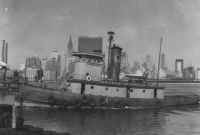|
Jakobson Shipyard, West End Avenue, Oyster Bay, NY
Photos, data and captions provided by: Dave Keller, unless noted otherwise
|
|
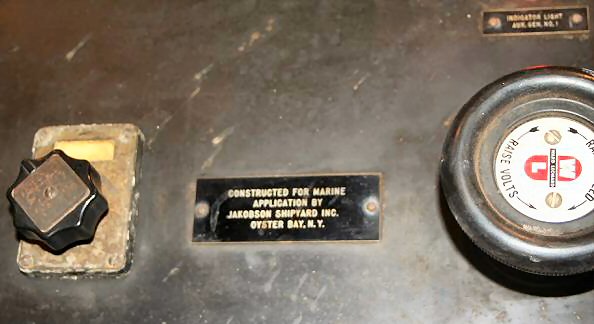
Builders plate on the Tug Cornell. It's the switchboard for all power and
the rheostats, etc. Photo/Info: Paul Strubeck
|
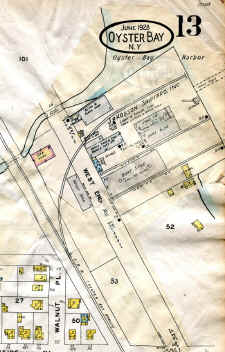
Sanborn - Oyster Bay 1941 Overlay map Jakobson Shipyard
Archive:
Oyster Bay Historical Society
|
While
the original map is dated June, 1928, there have been two overlays added
showing changes to the area. The first overlay is from 1934, and the
second overlay is from 1941, showing the siding into the shipyard as well
as the yard layout. (Data: Oyster Bay Historical Society)
Originating in Brooklyn in 1926, tracing its origin back to the Jakobson
& Peterson Shipyard built there in 1895, Jakobson Shipyard operated at
that location until they relocated to Oyster Bay in 1938.
This
map shows no dry dock facilities and only two tracks of the “Marine
Ry.” It also shows no launching ways.
In
1938, Jake’s was awarded a number of government contracts by the U. S.
Navy and were funded by them, to enlarge their facilities in Oyster Bay,
to build the small naval vessels and to move from their Brooklyn location
to put everything they had into Navy production and to keep it miles away
from snoopy noses and cameras. Before the war, it was quite a tiny place
with tiny dry dock and perhaps one tiny launching way on the west side of
the yard.
At
some point over the years, the Jakobson family sold the yard to the
Hossfeld family. George Hossfeld was the owner when I worked there.
The layout changed substantially over the years. Two launching ways
were added on the east side of the property, more buildings were
constructed and a large dry dock was added in addition to the smaller one
that had been there. When I worked at Jake’s, there might have
been 75-100 men working there. During WWII construction, the yard
employed over 700 men! I recall seeing LOTS of empty timecard racks
in the gatehouse and there were LOTS of empty lockers in the locker room
in the basement of the office building on West End Avenue.
Sometime, in the 1990's, Hossfeld sold the yard to
Moran Towing, who owned a good-sized fleet of tugboats and sometime after
that, all operations ceased.
During my time at "Jakes," the 1st building
below the blacksmith shop became a locker room, toilets, pipe fitters shop
and electric shop.
The
mould loft was still there upstairs but was no longer in use other than
for storage of the old wooden moulds.
The
office had its own building across West End Avenue, adjacent to the
LIRR’s ROW. Inside, it had a framed photo of the replica ship
“HMS Bounty” (used in the 1935 film ”Mutiny on the Bounty”) tied
to the long pier at Jakobson Shipyard, taken in, I believe, 1939! As
mentioned above, the basement of the office housed a locker room, some
showers and a lunchroom.
The
stock room was moved to the building closer to water’s edge.
The
saw mill was moved to its own building about where the southern
“lockers” building is shown and a complete carpentry shop took over
the entire building, with the ship fitters department office also therein.
And
more boat storage buildings were installed as well as the Marine Ry.
crossing West End Ave. and the quarter turntable being installed with the
larger boat storage house east of the turntable.
|
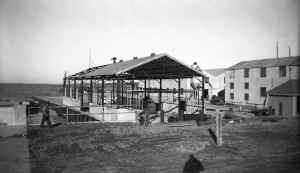
|
The
Blacksmith/ Forge Shop is under construction in this 1940 view looking
north from in front of where the shipyard office was located. The small building
at the far right is the gatehouse where the on-duty guard was stationed
and all the time cards and the time clock were located for yard
workers to punch in and out. The larger building in the right
background in later years housed the electrical shop, pipe-fitter’s
shop, and toilet facilities on the 1st floor and mould loft
(housing templates made for repeat-style ship construction) on the 2nd
floor.
The building behind the Blacksmith / Forge
Shop, visible through its structural steel housed the stock room with
another loft upstairs, unused at the time I worked there. (T. R. Sommer
photo)
|
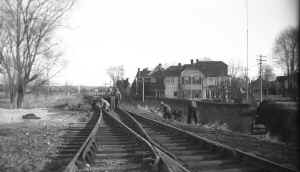
|
Long
Island Rail Road supervisors are inspecting the newly installed switch to
the new siding into the shipyard. This view is looking east – 1940 (T.
R. Sommer photo)
|
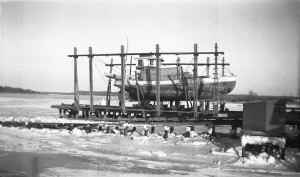
|
It’s an extremely frigid day on Oyster Bay in 1940 as evidenced by the fact that the bay is, indeed, frozen! The little ship “Earle” is in dry dock. This view is looking northeast. In later years, a much larger dry dock was added just east of this smaller one. The smaller one relegated for repairs on sailboats and the larger one for all other major repairs, like tugboats. (T. R. Sommer photo)
|
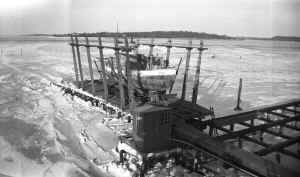
|
Here’s a nice elevated view of the “Earle” in dry dock as viewed in 1940 from the old fixed crane at water’s edge. We’re looking northeast here and the transfer table is visible to the lower right. Small
sailboats were taken up into dry dock, then pulled onto the transfer table on home-made railcars and then pulled onto repair tracks for
cleaning or repair, mast removal then pulled into storage sheds for the winter. When I worked in the yard, these cars were pulled by a large
forklift. (T. R. Sommer photo)
|
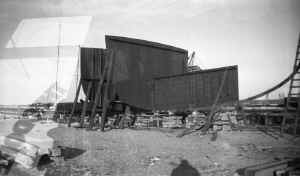
|
This view shows a tugboat under construction, looking northeast on the west side of the yard in 1940, which was the original location of the launching ways. In later years, the launching ways were relocated
to the east side of the yard and this area became part of the main dock. The keel is visible, having been laid on wooden keel blocks and
three bulkheads are already in place. Upon launching, the ship fitters had to crawl under the hull, a row of men on the port side and a row of
men on the starboard side, and, laying on their sides in cramped conditions, had to break the keel blocks apart chunk by chunk with a 5
pound maul and steel wedges. The main support was later placed upon the sliding wooden supports on each side of the hull which were
built up once the shipbuilding was underway. Once the keel blocks had been totally removed, the ship fitters crawled back out from under the
boat and she was officially launched. I was a ship fitter. I really enjoyed this part of the job! Yeah . . . right! Glad I wasn’t
claustrophobic! (T. R. Sommer photo)
|
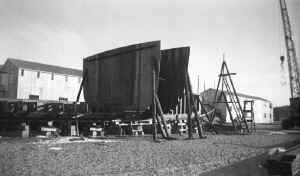
|
Here’s another view of the same tug under construction only looking southeast. The water is directly behind the photographer and in the background can be seen the shop buildings. This is also 1940. (T. R. Sommer photo)
|
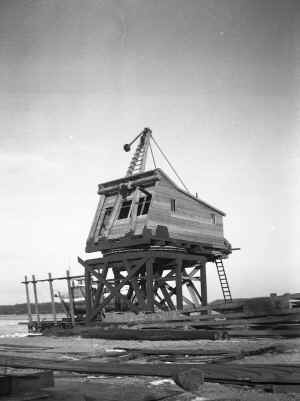
|
Here’s a 1940 view of the old fixed crane at water’s edge. We’re looking northeast and the small dry dock with the “Earle” is visible behind the structure. (T. R. Sommer photo)
|
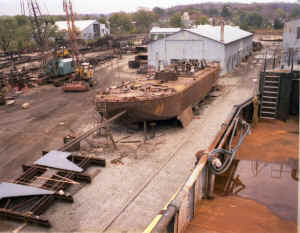
|
Now we jump ahead to
December, 1984 when I worked at “Jake’s.” I took this view
looking southeast from the flying bridge of the “Islander” which was
in for hull repair. In the foreground can be seen the wide-gauge
rails used to pull the sailboats. Further in the distance can be seen
one of the sailboat storage sheds at the far right and at the left, behind
the newly-constructed work barge, the building that housed the carpentry
shop and the ship fitters department. That’s the building to which I
reported each morning and where we had our tool boxes stored.
In the distance, that black thing is the quarter-turn turntable,
which allowed the sailboats to be pulled to the left, and into the
larger boathouse at the very far left background, which was located
alongside the fence separating the yard from the LIRR’s
right-of-way.
At the far left behind the cranes are the launching ways and
between them and West End Avenue were the plate racks where steel plates
for bulkheads and hulls were stored. Some plates are still visible
in the distant racks. Construction in the yard was dead at this time.
No new construction was underway. Only repair work kept the place
open. Men had been getting laid off every week. I was laid off the
next month. In later years, the yard was sold to Moran Towing.
Moran had a large fleet of tugboats.
|
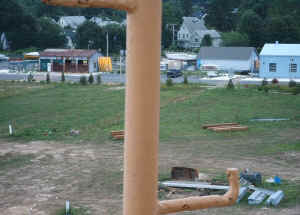
|
This is an “after” shot, taken in 2006 to my “before” shot above. It’s a little closer to West End Avenue than my shot from the “Islander,” but it shows the remains of the wide-gauge tracks, only visible crossing the street and ending at the still-extant quarter-turn turntable. Everything else is gone. The 4-bay garage at the left is all that’s left of the yard buildings. Part of this structure is visible in my elevated shot above.
This view was taken from the crow’s nest of the
Nantucket
Light Ship that was tied to the shorter, replacement pier built after the
shipyard was removed. She was there for restoration at the time,
but, according to the photographer, Pat Masterson, she is no longer being
restored due to the age-old problem of “lack of funds.”
(Photo: Pat Masterson)
|
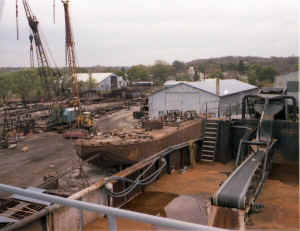
|
This is another yard view from December, 1984, similar to an earlier scene, only taken from in front of the bridge of the “Islander.” The view is looking southeast.
|
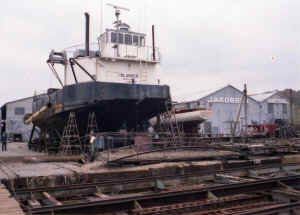
|
Here is a rear view of the “Islander” looking southwest towards the shop buildings. In the foreground directly behind the stern of the ship is a portable gangway and in the very foreground, part of the transfer table that had the “LIRR 1878” marked rail atop. December, 1984.
|
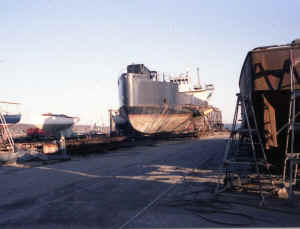
|
Here’s a bow view of the “Islander” looking north towards the larger dry dock which is empty at this time. The wide gauge track is visible in the
foreground and a work barge is at the far right. December, 1984
|
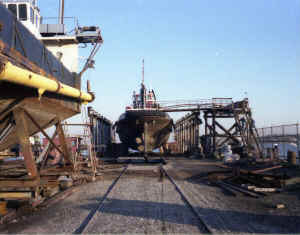
|
This view
looking north shows a Moran tugboat on the larger dry dock. The
“M” logo on the stack is visible in the next photo. Unfortunately I
did not write the name of the boat down nor is it visible in the
photo. The portable gangway has been set between the access platform
and the rail of the boat. In the foreground are the wide gauge
tracks. December, 1984.
|
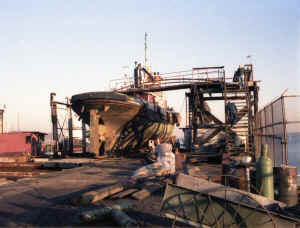
|
Another view of the same tug in dry dock . . . . ¾ view this time. At the far left in the background can be seen a Texaco tugboat at dock awaiting repair. December, 1984.
The stack is black and there’s a large white “M” logo painted on it.
|
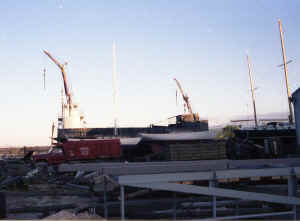
|
Nothing special here. Just a view looking east from the main dock in front of the shop buildings. The “Islander” in the background and a couple of crane booms shooting up into the air. December, 1984.
|
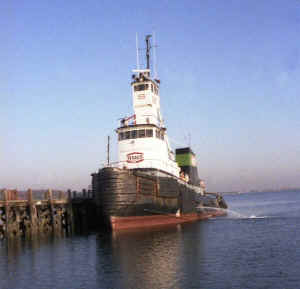
|
A nice view of the Texaco tug “Diesel Chief” at dock awaiting repair. Check out that super-high auxiliary bridge atop the main bridge! That allowed for better visibility when pushing tall barges
or other ships. December, 1984.
|
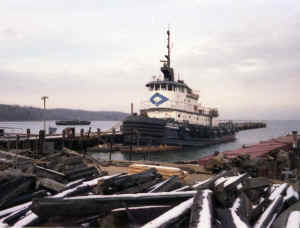
|
Here is the tug “Cape Henlopen” tied up at the main dock, awaiting repairs. No idea to whom she belongs after all this time. We’ve had some snow since the earlier sunny photos. December, 1984
|
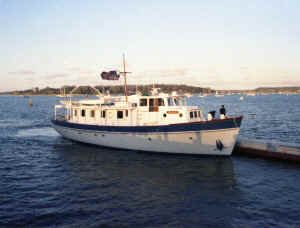
|
The private yacht “Dragoon” is maneuvering into the secondary dock which jutted off on a northwesterly skew from the long, main pier. Big bucks here. The crew is in uniform. December, 1984
|
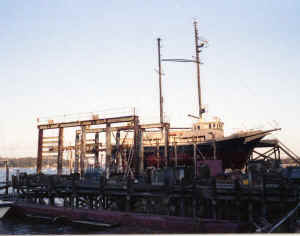
|
In the larger dry dock is a large Polish yacht in for repairs. Again,
I never wrote the name down, but even if I had, it would have been unpronounceable. The ship was constructed in Szechin in what was once East Prussia but later became a portion of Poland to allow that nation access to the North Sea. The city of Gdansk, with it’s famous shipyard is the Polish version of the East Prussian city of
Danzig. Enough history . . . . back to the ship. The entire hull is steel, but the upper portion is all teakwood that had badly weathered. It
was splintery and faded but must have been beautiful when new! December, 1984
|
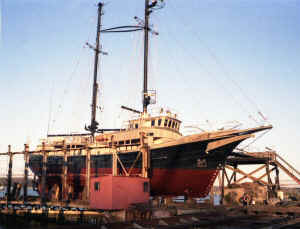
|
Here’s a closer and better view of the Polish ship, displaying her sleek lines. December, 1984
|
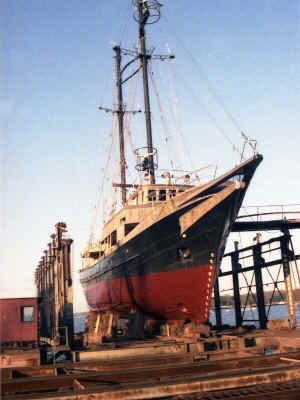
|
And, a front, ¾ view, REALLY displaying her sleek lines! A beautiful vessel. December, 1984
|
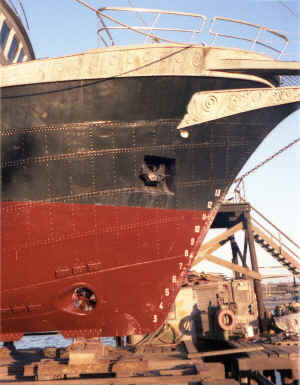
|
This close-up of the Polish ship shows the depth numbering on the bow, as well as the anchor (located in black-painted area) and smaller propellers (located in red-painted area) used for maneuvering the bow
into or away from the dock. These small propellers serve the same purpose as retro rockets used to serve on the old space capsules. The
fancy, beige-colored teakwood is visible along the rail and prow. December, 1984
|
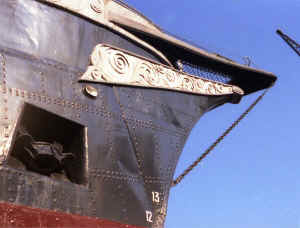
|
Here’s a close-up of the prow and anchor of the Polish ship. December, 1984
|
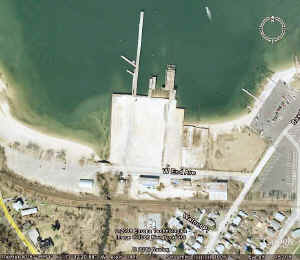
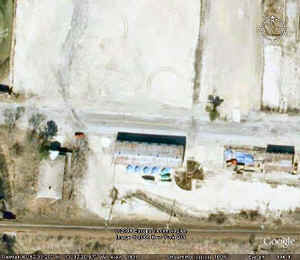
|
This is a satellite view of the location of the shipyard taken in the 1990s after all the structures had been removed, but the footprint still remained at that time. At the left is seen the dock edge along which the Blacksmith’s Shop was constructed.
Straight up, jutting into Oyster
Bay is the long main pier, with the two, skewed, secondary piers jutting out to the northwest. The northernmost of these two is the pier that
the above photo of the yacht “Dragoon” is approaching.
Follow the line
of the long pier straight down to the LIRR tracks below and you bump into the shipyard office. Upstairs were the yard offices. Downstairs
were the lunchroom, locker room and showers. To the right of the long pier is the location of the small sailboat dry dock. To the right of
that is the location of the larger dry dock. The cross-hatched area between the two dry docks is the transfer table.
All the way to the
right, where the beach shoreline curves down can be seen what’s left of the two launching ways, running north and south, used to launch
newly constructed tugboats. Between West End Avenue and the LIRR tracks, at the lower right part of the photo is one of the sailboat sheds
which was still standing at the time of this photo.
This was the shed that was accessible via tracks to and from the quarter-turn turntable
which is the circular item visible to the left, under the letter “W” of
“West End Avenue.”
Here’s a satellite view close-up of the quarter-turn turntable, still visible in the 1990s.
|
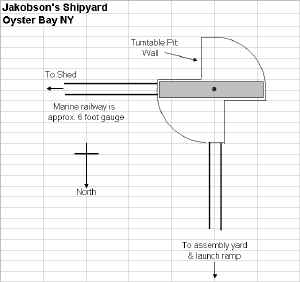
|
Jakobson's
Shipyard 1/4
Turntable Drawing: Stephen Rothaug Archive: Steve Lynch
|
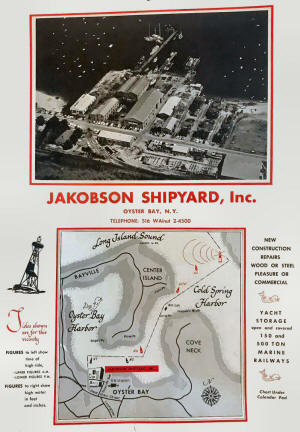
Jakobson
Shipyard, Oyster Bay c.1960 Archive: Henry P. Doll |
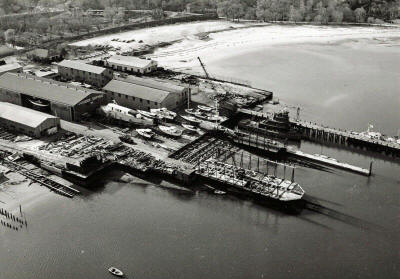
Jakobson
Shipyard, Oyster Bay aerial 1962 - Source: eBay |
| Jakobson
Alumni
|

C&O tugboat “Chessie”
Built Jakobson Shipyard, Oyster Bay, NY, 1983
|
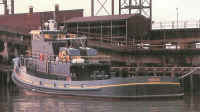
C&O tugboat “Chessie” September 27, 1985
|
|
Chessie:
Both photos attached are of the Chesapeake & Ohio tugboat “Chessie,”
Jakobson Class of 1983. The first shot was taken on December
26, 1983 when she was brand new and recently placed in C&O service.
Check out those fabulous sleek lines while viewing her from the stern.
What a terrific streamlined look for a tugboat!
The second shot was taken on September
27, 1985, also in C&O service and is a broadside view, giving you an
idea of the length of the boat. I worked on this boat as a ship
fitter and as a welder as I did on her sister tug the “Consort.”
Take my word for it: she’s got quite a
depth to her hull!!!! Both photos by “Chessie Mike”
|
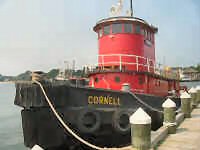
|
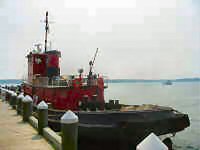
|
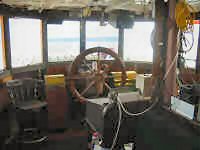
|
|
Cornell: Here are three views of the Jakobson tugboat “Cornell” docked at
Greenport, NY in August, 2007. She's a graduate of the Jakobson class of 1950. Photos: Paul Strubeck
|
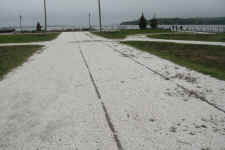
Ex-Jakobson Shipyard boat launch wide gauge track to LI Sound View N
05/05/12 Photo: Andy Ciavarella
|
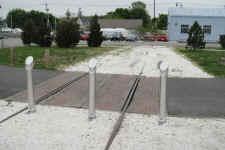
Ex-Jakobson Shipyard boat launch wide gauge track from LI Sound View S
05/05/12 Photo: Andy Ciavarella
|
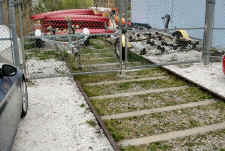
Ex-Jakobson Shipyard turntable View S 05/05/12 Photo: Andy Ciavarella
|
